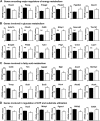RNA SEQ Analysis Indicates that the AE3 Cl-/HCO3- Exchanger Contributes to Active Transport-Mediated CO2 Disposal in Heart
- PMID: 28779178
- PMCID: PMC5544674
- DOI: 10.1038/s41598-017-07585-y
RNA SEQ Analysis Indicates that the AE3 Cl-/HCO3- Exchanger Contributes to Active Transport-Mediated CO2 Disposal in Heart
Abstract
Loss of the AE3 Cl-/HCO3- exchanger (Slc4a3) in mice causes an impaired cardiac force-frequency response and heart failure under some conditions but the mechanisms are not known. To better understand the functions of AE3, we performed RNA Seq analysis of AE3-null and wild-type mouse hearts and evaluated the data with respect to three hypotheses (CO2 disposal, facilitation of Na+-loading, and recovery from an alkaline load) that have been proposed for its physiological functions. Gene Ontology and PubMatrix analyses of differentially expressed genes revealed a hypoxia response and changes in vasodilation and angiogenesis genes that strongly support the CO2 disposal hypothesis. Differential expression of energy metabolism genes, which indicated increased glucose utilization and decreased fatty acid utilization, were consistent with adaptive responses to perturbations of O2/CO2 balance in AE3-null myocytes. Given that the myocardium is an obligate aerobic tissue and consumes large amounts of O2, the data suggest that loss of AE3, which has the potential to extrude CO2 in the form of HCO3-, impairs O2/CO2 balance in cardiac myocytes. These results support a model in which the AE3 Cl-/HCO3- exchanger, coupled with parallel Cl- and H+-extrusion mechanisms and extracellular carbonic anhydrase, is responsible for active transport-mediated disposal of CO2.
Conflict of interest statement
The authors declare that they have no competing interests.
Figures







Similar articles
-
Role of Cl- -HCO3- exchanger AE3 in intracellular pH homeostasis in cultured murine hippocampal neurons, and in crosstalk to adjacent astrocytes.J Physiol. 2017 Jan 1;595(1):93-124. doi: 10.1113/JP272470. Epub 2016 Nov 6. J Physiol. 2017. PMID: 27353306 Free PMC article.
-
Impaired cardiac contractility in mice lacking both the AE3 Cl-/HCO3- exchanger and the NKCC1 Na+-K+-2Cl- cotransporter: effects on Ca2+ handling and protein phosphatases.J Biol Chem. 2008 Nov 14;283(46):31303-14. doi: 10.1074/jbc.M803706200. Epub 2008 Sep 8. J Biol Chem. 2008. PMID: 18779325 Free PMC article.
-
The murine Cl⁻/HCO⁻₃ exchanger Ae3 (Slc4a3) is not required for acid-base balance but is involved in magnesium handling by the kidney.Cell Physiol Biochem. 2014;34(5):1566-77. doi: 10.1159/000366360. Epub 2014 Oct 31. Cell Physiol Biochem. 2014. PMID: 25402438
-
Molecular physiology of SLC4 anion exchangers.Exp Physiol. 2006 Jan;91(1):153-61. doi: 10.1113/expphysiol.2005.031765. Epub 2005 Oct 20. Exp Physiol. 2006. PMID: 16239253 Review.
-
Carotid body chemoreception: the importance of CO2-HCO3- and carbonic anhydrase. (review).Biol Res. 1993;26(3):319-29. Biol Res. 1993. PMID: 7606251 Review.
Cited by
-
Transcendent Aspects of Proton Channels.Annu Rev Physiol. 2024 Feb 12;86:357-377. doi: 10.1146/annurev-physiol-042222-023242. Epub 2023 Nov 6. Annu Rev Physiol. 2024. PMID: 37931166 Free PMC article. Review.
-
NBCe1 Na+-HCO3- cotransporter ablation causes reduced apoptosis following cardiac ischemia-reperfusion injury in vivo.World J Cardiol. 2018 Sep 26;10(9):97-109. doi: 10.4330/wjc.v10.i9.97. World J Cardiol. 2018. PMID: 30344957 Free PMC article.
-
RNA-Seq Analyses Reveal Roles of the HVCN1 Proton Channel in Cardiac pH Homeostasis.Front Cell Dev Biol. 2022 Mar 16;10:860502. doi: 10.3389/fcell.2022.860502. eCollection 2022. Front Cell Dev Biol. 2022. PMID: 35372367 Free PMC article.
-
The HVCN1 voltage-gated proton channel contributes to pH regulation in canine ventricular myocytes.J Physiol. 2022 May;600(9):2089-2103. doi: 10.1113/JP282126. Epub 2022 Mar 18. J Physiol. 2022. PMID: 35244217 Free PMC article.
-
Voltage and pH sensing by the voltage-gated proton channel, HV1.J R Soc Interface. 2018 Apr;15(141):20180108. doi: 10.1098/rsif.2018.0108. J R Soc Interface. 2018. PMID: 29643227 Free PMC article. Review.
References
Publication types
MeSH terms
Substances
Grants and funding
LinkOut - more resources
Full Text Sources
Other Literature Sources
Molecular Biology Databases

